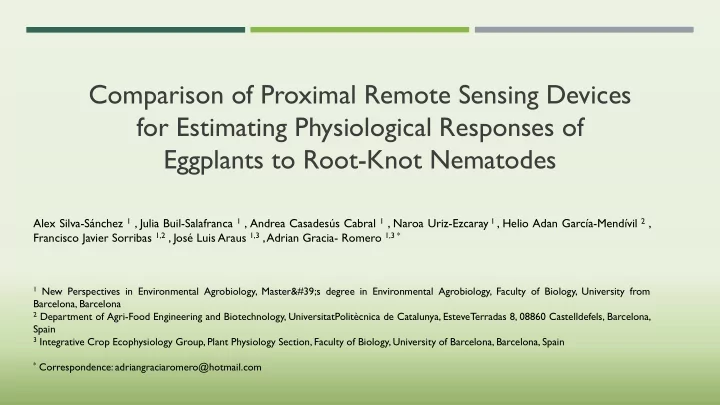

Comparison of Proximal Remote Sensing Devices for Estimating Physiological Responses of Eggplants to Root-Knot Nematodes Alex Silva-Sánchez 1 , Julia Buil-Salafranca 1 , Andrea Casadesús Cabral 1 , Naroa Uriz-Ezcaray 1 , Helio Adan García-Mendívil 2 , Francisco Javier Sorribas 1,2 , José Luis Araus 1,3 ,Adrian Gracia- Romero 1,3 * 1 New Perspectives in Environmental Agrobiology, Master's degree in Environmental Agrobiology, Faculty of Biology, University from Barcelona, Barcelona 2 Department of Agri-Food Engineering and Biotechnology, UniversitatPolitècnica de Catalunya, EsteveTerradas 8, 08860 Castelldefels, Barcelona, Spain 3 Integrative Crop Ecophysiology Group,Plant Physiology Section, Faculty of Biology, University of Barcelona, Barcelona, Spain * Correspondence: adriangraciaromero@hotmail.com
INTRODUCTION Assess plant diseases • Useful to • Detect stress Predict crop production • Remote sensing Index Measurements in field-conditions Fast Benefits Without plant material destruction Work at different scales Leaf • • Canopy
INTRODUCTION EGGPLANT Interest components: Threatened by • Phytochemical • Nutraceutical Meloidogyne javanica CAUSES OF THE ROOT -KNOT NEMATODE: Root damages • • Restriction of nutrient and water uptake Limit the production • Solanum melongena
INTRODUCTION EGGPLANT Interest components: Threatened by • Phytochemical • Nutraceutical Meloidogyne javanica POSSIBLE SOLUTION: Use of rootstocks tolerant for grafting the eggplants Solanum torvum Solanum melongena
INTRODUCTION AIM OF THE STUDY Compare different proximal remote sensing approaches at plant and single leaf to assess the effect in eggplant of grafting with the tolerant species Solanum torvum , and conclude which is more convenient to assess the eggplant response to nematode effects.
EXPERIMENTS Conditions Plant material and growing conditions Total plots: 20 x 4/plot 80 1/2 Agropolis. ESAB Soil infested with
EXPERIMENTS 1 st October. 15:00-17:00 Data collection Leaf based measurements Sensor Traits Sensor Traits • Quantum yield of photosystem II (PSII) • Chlorophyll (Chl) • Photochemistry ( Φ II ) • Flavonoid (Flav) • Non-photochemical quenching ( Φ NPQ ) Anthocyanin (Anth) • • Other unregulated non-photochemical Nitrogen balance index • losses ( Φ NO ) (NBI) Dualex MultispeQ • Relative chlorophyll content (Rel Chl) • Chl/Flav
EXPERIMENTS Sensor Traits Canopy-based measurements Normalized • Vegetation Sensor Traits Index (NDVI) Sensor Traits GreenSeeker T emperature • • RGB picture RGB picture • Sensor Traits Software • T emperature Software • CerealsMobile MosaicT ool • Camera Llumix GX7 PhotoT emp TM
RESULTS AND DISCUSSION Accuracy Measurement level Sensor/Technique Trait Sampling difficulty Sampling time Post-processing Destructiveness Cost ANOVA R Chlorophyll content ns 0.422 Anthocyanyn content ns 0.105 Dualex Flavonoids content ns -0.270 NBI ns 0.277 Leaf-based Phi2 ns 0.438 PhiNO ns -0.169 Photosynq PhiNPQ ns -0.388 Rel Chl ns 0.526 Fv'/Fm' ns 0.335 GreenSeeker NDVI * 0.601 Hue * 0.662 GA ** 0.706 RGB images GGA * 0.635 NGRDI ** 0.642 Infrared gun Canopy temperature ** -0.618 Canopy-based Hue ** 0.590 GA * 0.472 GGA ** 0.547 Thermal camera + RGB Canopy temperature ns -0.157 CT[GA] ns -0.154 CT[GGA] ns -0.154
RESULTS AND DISCUSSION Correlations between production and RGB parameters are >0,6
CONCLUSIONS • Single-leaf measurements did not show significant differences between grafted and non-grafted plants and with low correlations → Root-knot nematodes did not affect leaf chlorophylls. • Plant-based measurements showed significant differences between both types of plants and higher yield correlations with yield. RGB indexes showed best correlations with yield. Plant temperature also performed well assessing differences. • However, both categories of remote sensing traits (smartphone) were worse. → importance of how and when the temperature measurements are taken. • Dualex and Photosynq better if measured in an earlier phenological stage. • Canopy-based measurements permit to study the whole plot at once (without the need of replicates) and showed the best results. • RGB indexes are presented as a promising remote sensing technique mainly due to its user friendly and low-cost nature. It should be noted that this measurement can be easily taken with a simple smartphone.
Recommend
More recommend